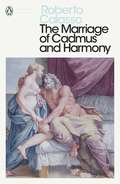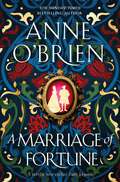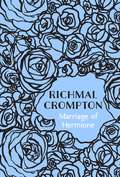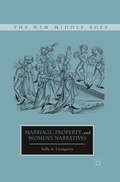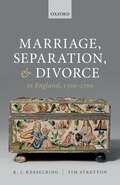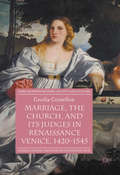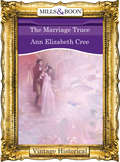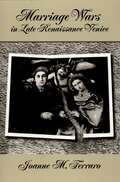- Table View
- List View
The Marriage of Cadmus and Harmony (Penguin Modern Classics)
by Roberto Calasso'It will be read and re-read not as a treatise but as a story: one of the most extraordinary that has ever been written of the origins of Western self-consciousness' Simon SchamaThe marriage of Cadmus and Harmony was the last time the gods of Olympus feasted alongside mortals. What happened in the distant ages preceding it, and in the generations that followed, form the timeless tales of ancient Greek mythology. In this masterful retelling of the myths we think we know, Roberto Calasso illuminates the deepest questions of our existence.'The kind of book one comes across only once or twice in one's lifetime' Joseph Brodsky'A perfect work like no other' Gore Vidal
A Marriage Of Equals (Mills And Boon Historical Ser.)
by Elizabeth RollsRisking everything… For love!
A Marriage of Fortune: The captivating new historical novel from the Sunday Times bestselling author
by Anne O'Brien'A compelling tale of a family caught up in the turmoil of the Wars of the Roses... Be warned: it's dangerously addictive' TRACY BORMANEngland. 1469.A fortunate marriage will change history.A scandal could destroy everything...Margaret Paston, matriarch of the Paston family, knows that a favourable match for one of her unruly daughters is the only way to survive the loss of their recently acquired Caister Castle. But as the War of the Roses rages on, dangerous enemies will threaten even her best laid plans.Margery Paston, her eldest daughter, has always strived to uphold the Paston name and do her mother proud. But when she loses her heart to a man below her station, she must make a terrible choice: will she betray her family and risk everything for a chance at true love?Anne Haute, first cousin to the Queen, is embroiled in a longstanding betrothal to Sir John Paston, the eldest son and heir to the Paston seat. But despite his promises, Anne can't help but doubt that he will ever keep his word and make her his wife...In the midst of civil war, each of these women must decide: Head or heart? Love or duty? Reputation- or scandal?Praise for A Marriage of Fortune:'Anne O'Brien gets right inside the heads of her medieval characters!' JOANNA HICKSON'Magnificently researched... an enthralling story of strong women and advantageous marriages. I was completely hooked!' CLARE MARCHANTA beautifully researched novel told with understanding, subtlety and a deft touch. Time travel at its best' JOANNA COURTNEY
Marriage of Hermione
by Richmal CromptonAged just seventeen Hermione is passed from the hands of an inattentive mother into an engagement with a young man she barely knows. Glad to have her pretty daughter married and celebrated by their social circle, Hermione's mother gives little thought to the fitness of the match. Hermione now finds she must grow up, and grow into a life with a man who is not her natural partner. Following Hermione and her family from the late eighteen hundreds through the First World War and the changing society of the post-war era, in Marriage of Hermione Richmal Crompton explores the strains and joys of an imperfect marriage with a warm and humorous eye.Richmal Crompton's adult novels are an absolute delight and every bit as charming as her beloved Just William series. A nostalgic treat for fans of the gentler brand of interwar fiction, this is the perfect heritage read for fans of 1930s fiction at its best.
A Marriage of Inconvenience (Regency Flame #8)
by M.C. BeatonThe second book in M.C. Beaton's charming Regency Flame series. He stated quite bluntly - and much to Isabella's relief - that theirs would be a marriage in name only. But neither Harry nor Isabella was aware of the other's disguise - contrived in vain to thwart the impending nuptials. Isabella was not the selfish ice princess she seemed, nor was Harry a mincing dandy, but a prime Corinthian.A search for buried treasure and a thwarted suitor out for revenge add adventure to the marital mayhem, as two hearts discover that love lies no farther than the nearest kiss.Searching for lighter romances set in the English countryside? Look no farther than the Regency Flame Series, which features mistaken identities, botched marriages, witty heroines, and the courtship of prime Corinthians.
Marriage of Inconvenience (Mills And Boon Love Inspired Historical Ser.)
by Cheryl BolenFROM BLUESTOCKING TO BRIDE
A Marriage of Lions: An auspicious match. An invitation to war.
by Elizabeth ChadwickAn auspicious match, an invitation to war.'Picking up an Elizabeth Chadwick novel you know you are in for a sumptuous ride'Daily Telegraph*England, 1238 Raised at the court of King Henry III as a chamber lady to the queen, young Joanna of Swanscombe's life changes forever when she comes into an inheritance far above all expectations, including her own. Now a wealthy heiress, Joanna's arranged marriage to the King's charming, tournament-loving half-brother William de Valence immediately stokes the flames of political unrest as more established courtiers object to the privileges bestowed on newcomers. As Joanna and William strive to build a life together, England descends into a bitter civil war. In mortal danger, William is forced to run for his life, and Joanna is left with only her wit and courage to outfox their enemies and prevent them from destroying her husband, her family, and their fortunes.*Praise for Elizabeth Chadwick'An author who makes history come gloriously alive'The Times'Stunning . . . Her characters are beguiling, and the story is intriguing'Barbara Erskine'I rank Elizabeth Chadwick with such historical novelist stars as Dorothy Dunnett and Anya Seton'Sharon Kay Penman'Enjoyable and sensuous'Daily Mail'Meticulous research and strong storytelling'Woman & Home'A riveting read . . . A glorious adventure not to be missed!'Candis
Marriage of Mercy (Mills And Boon Historical Ser.)
by Carla KellyIndulge your fantasies of delicious Regency Rakes, fierce Viking warriors and rugged Highlanders. Be swept away into a world of intense passion, lavish settings and romance that burns brightly through the centuries MARRYING THE WRONG GROOM…
A Marriage of Notoriety: A Reputation For Notoriety / A Marriage Of Notoriety (The Masquerade Club #2)
by Diane GastonThe scars she keeps hidden… The mysterious pianiste is the Masquerade Club's newest attraction, captivating guests with her haunting music. What is the true identity of the lady concealed beneath the mask?
A Marriage Of Rogues: A Marriage Of Rogues The Cowboy's Cinderella Sold To The Viking Warrior (Mills And Boon Historical Ser.)
by Margaret MooreHe made a dangerous wager…and won himself a wife
Marriage Or Ruin For The Heiress (The Osterlund Saga #1)
by Lauri RobinsonA pretend marriage A passion that’s anything but…
Marriage, Property, and Women's Narratives (The New Middle Ages)
by S. LivingstonAn interdisciplinary approach to the study of women and property, combining literature, history, and economics. By looking at women's marriage narratives over a long period of time, the book reveals the deep discontent with the institution of property ownership as a unifying thread from the Middle Ages up through the twentieth-century.
The Marriage Question: George Eliot's Double Life
by Clare Carlisle*A Times, Telegraph, TLS and Prospect Book of the Year*‘The best book I've read on George Eliot’ John Carey, Sunday TimesAn exceptional new biography that shows how George Eliot wrestled with the question of marriage, in art and lifeWhen she was in her mid-thirties, Marian Evans transformed herself into George Eliot - an author celebrated for her genius as soon as she published her debut novel. During those years she also found her life partner, George Lewes - writer, philosopher and married father of three. After 'eloping' to Berlin in 1854 they lived together for twenty-four years: Eliot asked people to call her 'Mrs Lewes' and dedicated each novel to her 'Husband'. Though they could not legally marry, she felt herself initiated into the 'great experience' of marriage - 'this double life, which helps me to feel and think with double strength'. The relationship scandalized her contemporaries yet she grew immeasurably within it. Living at once inside and outside marriage, Eliot could experience this form of life - so familiar yet also so perplexing - from both sides.In The Marriage Question Clare Carlisle reveals Eliot to be not only a great artist but a brilliant philosopher who probes the tensions and complexities of a shared life. Through the immense ambition and dark marriage plots of her novels we see Eliot wrestling - in art and in life - with themes of desire and sacrifice, motherhood and creativity, trust and disillusion, destiny and chance. Reading them afresh, Carlisle's searching new biography explores how marriage questions grow and change, and joins Eliot in her struggle to marry thought and feeling.
The Marriage Rescue (Mills And Boon Historical Ser. #Vol. 592)
by Joanna JohnsonRescued by her enemy Will she meet him at the altar?
Marriage, Separation, and Divorce in England, 1500-1700
by K. J. Kesselring Tim StrettonEngland is well known as the only Protestant state not to introduce divorce in the sixteenth-century Reformation. Only at the end of the seventeenth century did divorce by private act of parliament become available for a select few men and only in 1857 did the Divorce Act and its creation of judicial divorces extend the possibility more broadly. Aspects of the history of divorce are well known from studies which typically privilege the records of the church courts that claimed a monopoly on marriage. But why did England alone of all Protestant jurisdictions not allow divorce with remarriage in the era of the Reformation, and how did people in failed marriages cope with this absence? One part of the answer to the first question, Kesselring and Stretton argue, and a factor that shaped people's responses to the second, lay in another distinctive aspect of English law: its common-law formulation of coverture, the umbrella term for married women's legal status and property rights. The bonds of marriage stayed tightly tied in post-Reformation England in part because marriage was as much about wealth as it was about salvation or sexuality, and English society had deeply invested in a system that subordinated a wife's identity and property to those of the man she married. To understand this dimension of divorce's history, this study looks beyond the church courts to the records of other judicial bodies, the secular courts of common law and equity, to bring fresh perspective to a history that remains relevant today.
Marriage, Separation, and Divorce in England, 1500-1700
by Tim Stretton K. J. KesselringEngland is well known as the only Protestant state not to introduce divorce in the sixteenth-century Reformation. Only at the end of the seventeenth century did divorce by private act of parliament become available for a select few men and only in 1857 did the Divorce Act and its creation of judicial divorces extend the possibility more broadly. Aspects of the history of divorce are well known from studies which typically privilege the records of the church courts that claimed a monopoly on marriage. But why did England alone of all Protestant jurisdictions not allow divorce with remarriage in the era of the Reformation, and how did people in failed marriages cope with this absence? One part of the answer to the first question, Kesselring and Stretton argue, and a factor that shaped people's responses to the second, lay in another distinctive aspect of English law: its common-law formulation of coverture, the umbrella term for married women's legal status and property rights. The bonds of marriage stayed tightly tied in post-Reformation England in part because marriage was as much about wealth as it was about salvation or sexuality, and English society had deeply invested in a system that subordinated a wife's identity and property to those of the man she married. To understand this dimension of divorce's history, this study looks beyond the church courts to the records of other judicial bodies, the secular courts of common law and equity, to bring fresh perspective to a history that remains relevant today.
Marriage, the Church, and its Judges in Renaissance Venice, 1420-1545
by Cecilia CristellonThis book investigates the actions of marriage tribunals by analyzing the richest source of marriage suits extant in Italy, those of the Venetian ecclesiastical tribunal, between 1420 and the opening of the Council of Trent. It offers a strongly representative overview of the changes the Council introduced to centuries-old marriage practices, relegating it to the realm of marginality and deviance and nearly erasing the memory of it altogether. From the eleventh century onward, the Church assured itself of a jurisdictional monopoly over the matter of marriage, operating both in concert and in conflict with secular authorities by virtue of marriage’s civil consequences, the first of which regarded the legitimacy of children. Secular tribunals were responsible for patrimonial matters between spouses, though the Church at times inserted itself into these matters either directly, by substituting itself for the secular authority, or indirectly, by influencing Rulings through their own sentences. Lay magistratures, for their part, somewhat eroded the authority of ecclesiastical tribunals by continuing to exercise autonomous jurisdiction over marriage, especially regarding separation and crimes strictly connected to the nuptial bond and its definition, including adultery, bigamy, and rape.
Marriage, the Church, and its Judges in Renaissance Venice, 1420-1545
by Cecilia CristellonThis book investigates the actions of marriage tribunals by analyzing the richest source of marriage suits extant in Italy, those of the Venetian ecclesiastical tribunal, between 1420 and the opening of the Council of Trent. It offers a strongly representative overview of the changes the Council introduced to centuries-old marriage practices, relegating it to the realm of marginality and deviance and nearly erasing the memory of it altogether. From the eleventh century onward, the Church assured itself of a jurisdictional monopoly over the matter of marriage, operating both in concert and in conflict with secular authorities by virtue of marriage’s civil consequences, the first of which regarded the legitimacy of children. Secular tribunals were responsible for patrimonial matters between spouses, though the Church at times inserted itself into these matters either directly, by substituting itself for the secular authority, or indirectly, by influencing Rulings through their own sentences. Lay magistratures, for their part, somewhat eroded the authority of ecclesiastical tribunals by continuing to exercise autonomous jurisdiction over marriage, especially regarding separation and crimes strictly connected to the nuptial bond and its definition, including adultery, bigamy, and rape.
Marriage to Death: The Conflation of Wedding and Funeral Rituals in Greek Tragedy (Princeton Legacy Library #5260)
by Rush RehmThe link between weddings and death—as found in dramas ranging from Romeo and Juliet to Lorca's Blood Wedding—plays a central role in the action of many Greek tragedies. Female characters such as Kassandra, Antigone, and Helen enact and refer to significant parts of wedding and funeral rites, but often in a twisted fashion. Over time the pressure of dramatic events causes the distinctions between weddings and funerals to disappear. In this book, Rush Rehm considers how and why the conflation of the two ceremonies comes to theatrical life in the tragedies of Aeschylus, Sophokles, and Euripides. By focusing on the dramatization of important rituals conducted by women in ancient Athenian society, Rehm offers a new perspective on Greek tragedy and the challenges it posed for its audience.The conflation of weddings and funerals, the author argues, unleashes a kind of dramatic alchemy whereby female characters become the bearers of new possibilities. Such as formulation enables the tragedians to explore the limitations of traditional thinking and acting in fifth-century Athens. Rehm finds that when tragic weddings and funerals become confused and perverted, the aftershocks disturb the political and ideological givens of Athenian society, challenging the audience to consider new, and often radically different, directions for their city.Rush Rehm is Assistant Professor of Drama and Classics at Standford University and a free-lance theater director. He is the author of Greek Tragic Theatre (Routledge) and Aeschylus' Oresteia: A Theatre Vision (Hawthorn).Originally published in 1994.The Princeton Legacy Library uses the latest print-on-demand technology to again make available previously out-of-print books from the distinguished backlist of Princeton University Press. These editions preserve the original texts of these important books while presenting them in durable paperback and hardcover editions. The goal of the Princeton Legacy Library is to vastly increase access to the rich scholarly heritage found in the thousands of books published by Princeton University Press since its founding in 1905.
A Marriage To Shock Society
by null Joanna JohnsonThe Earl she shouldn’t have met The wedding that shouldn’t have happened! Having lived at the Laycock School for Young Ladies since the day she was born, Emily Townsend thinks she is finally about to meet her father… Only to mistakenly arrive at the estate of dashing Andrew Gouldsmith, Earl Breamore, instead! Determined Emily needs access to the ton if she’s to resume her search, and Andrew needs a convenient wife. But can their unconventional—and surprisingly passionate!—marriage survive Society’s scrutinous gaze?
Marriage Under Siege (Mira Ser.)
by Anne O'Brien‘Anne O’Brien has joined the exclusive club of excellent historical novelists.’ - Sunday Express ‘Will you hold the castle for me, lady, in my name?’ He does not know me. He does not trust me.
Marriage Wars in Late Renaissance Venice (Studies in the History of Sexuality)
by Joanne M. FerraroBased on a fascinating body of previously unexamined archival material, this book brings to life the lost voices of ordinary Venetians during the age of Catholic revival. Looking at scripts that were brought to the city's ecclesiastical courts by spouses seeking to annul their marriage vows, this book opens up the emotional world of intimacy and conflict, sexuality, and living arrangements that did not fit normative models of marriage.
Marriage Wars in Late Renaissance Venice (Studies in the History of Sexuality)
by Joanne M. FerraroBased on a fascinating body of previously unexamined archival material, this book brings to life the lost voices of ordinary Venetians during the age of Catholic revival. Looking at scripts that were brought to the city's ecclesiastical courts by spouses seeking to annul their marriage vows, this book opens up the emotional world of intimacy and conflict, sexuality, and living arrangements that did not fit normative models of marriage.
Marriage With My Kingdom: The Courtships Of Elizabeth I
by Alison PlowdenBorn in 1533, Elizabeth I was the product of the doomed marriage of Henry VIII and Anne Boleyn. In 1558, on her Catholic sister Mary's death, she ascended the throne and reigned for 45 years. Loved and respected by her subjects and idolised by future generations, Gloriana's fierce devotion to her country and its people made her England's fairest queen and icon. Royal marriage in the age of Elizabeth was a political business. Unions between great familes could be the key to security at home and to the making of great empires. No one represented a better prize than Elizabeth. She encouraged attention and spent her life surrounded by suitors, but she remained, until the end, married only to her kingdom. This, the third volume of Alison Plowden's Elizabethan quartet, plots the true story of the Virgin Queen's courtships and her career as "the greatest tease in history".
